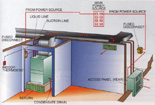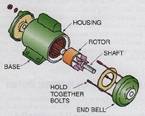The dispatcher called Bob and sent him to a job that really sounded like a problem. There had been a hard rain and a customer had a condensing unit that had been under water that morning due to high water from a creek behind his house. The condenser was at the lower end of the car port. The house did not get any water inside it. The water had never been this high at this house, and the owners had lived there for 51 years. The owners were on a fixed income and wanted to get the repair at the best possible price.
Bob arrived at the residence and could see that the water had in fact been up over the fan motor and the controls. Fortunately, the water looked to have been fairly clear, not muddy.
Bob talked to the homeowner and discovered that the condensing unit was the only thing that was flooded. The man had seen the water coming up and pulled his car to higher ground and shut off the breaker to the condensing unit. The owner again expressed the need for economy. Bob explained, “I will do everything I can to reduce the expenses. By the way, is there a breaker for this unit at the main breaker box? I think that the disconnect at the unit may be wet and I want to be careful.”

Figure 1. This is a similar arrangement to the service call in that it has two shutoff switches, a breaker at the main panel and a fused disconnect switch at the unit. (Figures are from Refrigeration & Air Conditioning Technology, 5th Edition, by William Whitman, William Johnson, and John Tomczyk, published by Delmar Cengage Learning.) (©Delmar Cengage Learning.) (Click on the image for an enlarged view.)
Bob pulled his truck down to the area close to the condensing unit. He checked the voltage at the condensing unit breaker and found no power. He shut that breaker off and looked for signs of water. This breaker was above the water line of the flood.
Bob removed the cover to the control panel of the unit and saw where the water level had been above the controls. He looked at the condenser fan and it had been under water, too. He was standing there scratching his head when Btu Buddy appeared and asked, “What is the problem, Bob?”
Bob explained the situation as well as the financial burden it would put on the customer to properly fix this system by replacing the controls, capacitors, and the fan motor. He really did not like what he was seeing.
Btu Buddy said, “I am glad that you feel the need of this customer. I think that we can take some precautious short cuts and get many more years of service out of this unit. If you stop and think about it, probably every component in this system has probably been wet at some time during manufacturing. How are they working together now?”
Bob said, “Well, of course they were dried. They are assembled now and I don’t see how they can be dried while assembled.”
Btu Buddy said, “Make a list of the components that you think would be hard to dry.”
Bob made a list:
1.The contactor coil and contacts
2.The circuit board
3.The capacitors
4.The condenser fan motor
5.The compressor motor terminals
6.The crankcase heater
Btu Buddy said, “Let’s start with the contactor. Remove the cover and use your air hose and blow out the contacts and the coil as best as you can. Remember that when you get the contact dry, that is the only high voltage component in the contactor. The coil is low voltage.”
Bob did as directed by removing the cover to the contacts. When he got to the coil, he commented, “This coil in encased in plastic. It would be hard for water to get inside.”
Btu Buddy then said, “Disconnect the wiring to the contactor and check the coil to ground using your ohmmeter and the Rx10,000 scale. If it is digital, use the highest ohm scale. You can test it by holding one lead in each hand and it will read through the resistance in your body. If it will read a resistance through your body, it will read any ground in that coil.”
Bob checked the coil and said, “This coil shows no resistance to ground. I think it is good. That is a relief.”
Btu Buddy then said, “It shows no resistance to ground, but there may be some water in the coil and still have a circuit from coil to coil. Now use your air hose and blow the circuit board down, both front and back. Also blow down the connections to the board.”
Bob then did this job.
Btu Buddy said, “Use the air hose to blow off the tops of the capacitors. Those are high voltage connections.”
Bob blew down the capacitor connections.

Figure 2. This is an illustration of a disassembled motor. (©Delmar Cengage Learning.) (Click on the image for an enlarged view.)
Bob disassembled the motor and blew it as dry as he could and then asked, “What about the bearing oil cavities? They are probably wet.”
Btu Buddy said, “I was hoping you would see that as a problem. The water came up on this unit and went down in a matter of hours and the water was not very dirty. We got to this unit before it sat very long. My guess and our gamble on this job is that those bearing cavities can be purged of water with WD-40. Remember, the WD stands for water displacement. I think we can risk a good flush job. The motor may fail at another time, but I think we can get more years out of the motor. You can tell the homeowner what we did and that the fan motor is no guarantee. I think he will be willing to take the chance.”
Bob flushed the oil cavities until he thought they must be clean. He followed it up by flushing it with regular motor lubricating oil.
Btu Buddy said, “The motor has been disassembled and laying in the sun for awhile. Check the motor leads to the motor housing for a ground circuit.”
Bob checked and said, “It is not showing a circuit to ground. I believe it is good. I am going to assemble it back together.”
Btu Buddy said, “I think you are right. Be sure to oil the shaft and the inside of the bearings as you assemble the motor. When you get it back together, remove the terminal cover for the compressor and blow the terminals out with air.”
Bob said, “I think everything is ready to run. The fan motor went back together and is in place.”
Btu Buddy then said, “Let’s make one more check to ground from the line side of the contactor. We have not checked the crankcase heater, but if it is grounded, it will show up in this check. If we don’t see a ground there, I think we are ready to start the unit.”
Bob made the check from both line side wires to ground and everything looked good.
Btu Buddy then said to Bob, “Go in and tell the owner that you are going to turn the thermostat to the ‘off’ position and put power on the unit. Explain to him that he shouldn’t start the unit for at least 10 hours to give the crankcase heater time to boil any liquid out of the crankcase. The unit has been sitting for several hours with no crankcase heat.”
When Bob came back, he turned all of the power on to the unit and all seemed well.
As they were driving away, Bob said, “That call was all about knowing the equipment and its limitations. I sure am learning a lot. I was sure that I would need to change a lot of components on that unit.”
Btu Buddy noted, “A lot of the reason that we were able to do that call so economically was that the components did not stay under water for long and we checked them all electrically before turning power on to the components.”
Bob called the customer the next morning and the homeowner said the unit was running great and he thanked Bob for the great savings on the service call.
Publication date:08/23/2010


Report Abusive Comment